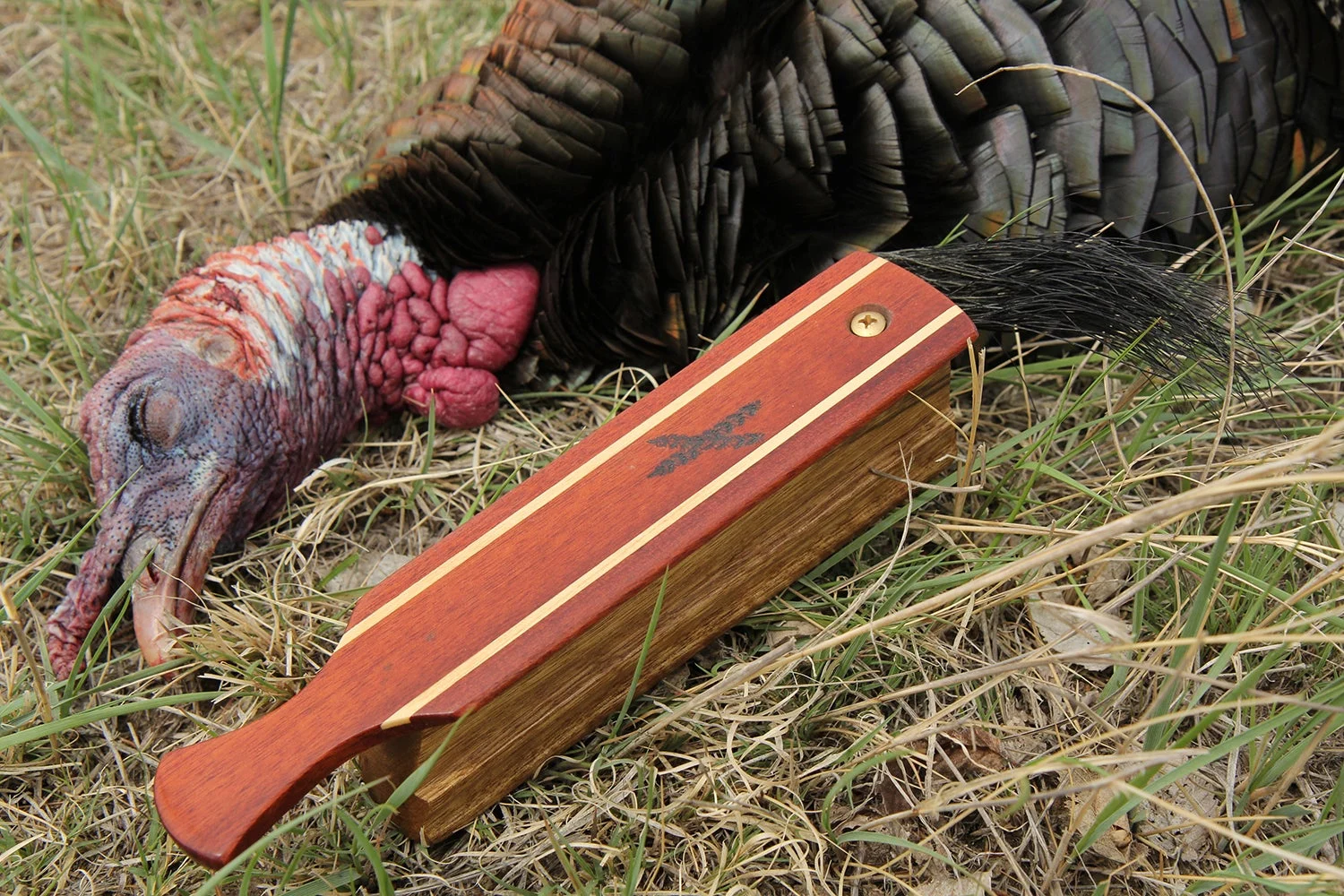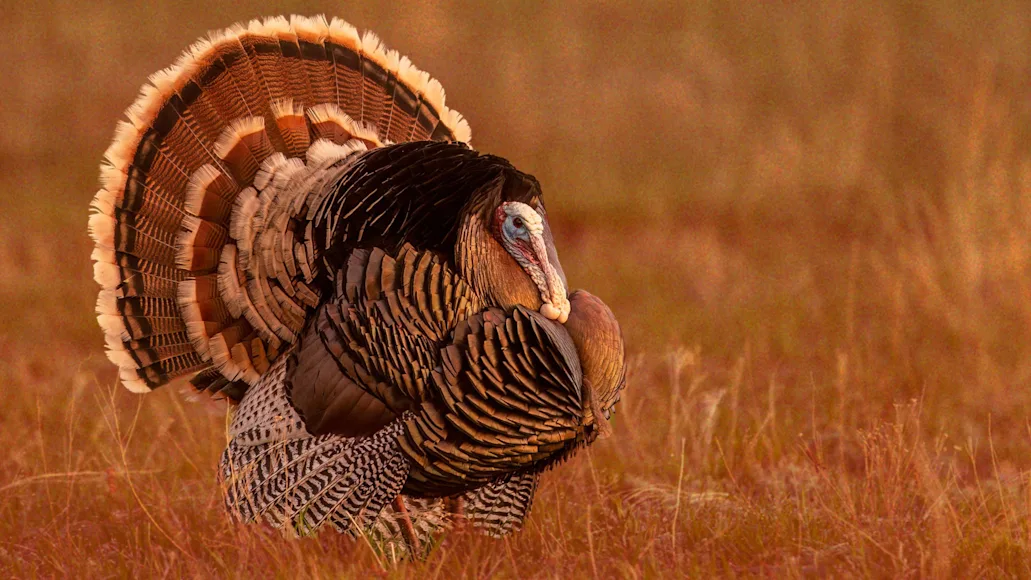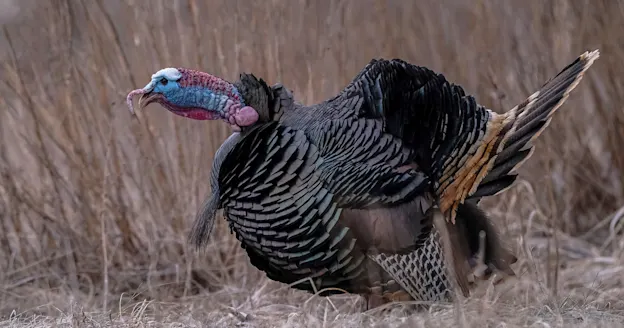THE GOBBLER stood in the shade of a far-off cedar, very still, as if he were impersonating a decoy. It was noon and hot, and Tim and I were planning to leave Nebraska that very day, ending not only our weeklong trip but another spring of turkey hunting. Having struck out on the morning hunt, I was ready to go home.
But Tim, who’d already filled both of his tags, talked me into having a go at the bird. He’d glassed the gobbler from a distance, so we parked his truck in a drainage between sandhills, maybe 400 yards away and out of sight of the tom, and I started after him.
I snuck along a cattle path, crawled past yucca plants, and finally wormed myself into playing distance. I leaned against a fence post with a clump of grass hiding me, and when I strained for a look over a roll in the field, I could see the gobbler still standing in the shade of the cedar, 150 yards away. It was a perfect situation. I could watch the turkey but broadcast my calls from behind the hill. If the gobbler wanted to investigate, he’d have to walk to 30 yards or closer to do it.
I put in a mouth call, yelped at him, and watched his response through my binocular. He turned his head slightly, and his snood actually got smaller. Through the glass, I could see two hooked spurs on his legs, and I knew he was an older turkey, the sort that sometimes won’t come to a call. Maybe he’d been thrashed by a gang of jakes or was just tired from a long spring of debauchery. Whatever the reason, it seemed like his most pressing desire was to stand in the shade and be left alone.
I yelped again, and he cocked his head, just once, a sure sign that he’d heard the call and didn’t care. I thought about saying to hell with him altogether, but instead I fished the box call out of my satchel and made four notes—a long opener, which was something of a whine, and then three sharper yelps, an announcement of sorts that I’ve heard often from excited hens that have walked in on other turkeys.
I didn’t need my binoculars to see the gobbler’s reaction. He took three steps into the bright sunshine and blew up into full strut.
Call History
I learned to call turkeys with a box call. My first was a Lynch Foolproof, which I carried for years and leaned on especially for striking birds at midday. My dad and I used to slip down four-wheeler trails in the timber, and he’d stop and whisper for me to “hit that box,” and then he’d sneak a few yards ahead and listen for a gobble. We had a lot of good ground and a lot of turkeys to hunt, so the education was Ivy League.
By the time I sat on that old box call and broke it—years later, while hunting in Nebraska—I’d all but quit using it anyway. I’d started using mouth calls most of the time because I thought they sounded better, were more versatile, and were a little cooler too. Box calls were like minivans or pontoon boats—functional, yes, but large and a little embarrassing when deployed.

The author’s “shirt-pocket” box call and the tom it fooled when no other call would elicit more than a glance from the gobbler. Will Brantley
I basically said as much to Bob Fulcher one evening as we were eating bland food at a Bob Evans in northern Ohio. I was deer hunting with Fulcher that week, but he’s a turkey hunting nut, same as me, and so that’s what we discussed most of the time. Fulcher, owner of Shadetree Callers, has won the National Wild Turkey Federation’s Grand National Custom Callmaking Competition. His calls aren’t just for show, either; though they’re handcrafted and look great, Fulcher is a turkey hunting guide who uses his own calls extensively.
He smiled as I carried on about the superiority of mouth calls, and then he offered to build a new box call for me to try out myself and maybe change my mind.
The Shirt-Pocket Box
Fulcher sent me a few different calls to try. The “shirt-pocket” box that he built was actually inscribed for my son, Anse, and Fulcher included with it a note about the future generation of turkey hunters. An 8-year-old has no business carrying on with something that nice, though, so I’ve taken the call for myself and may never give it back. Anse will have to get a job and buy his own Shadetree box call if he wants one.
The shirt-pocket box hasn’t replaced my mouth calls, but I use it just about every day that I hunt, and there are times when it will simply get a better response from turkeys than anything else. Why? It could be that it’s louder. I still don’t think it sounds as good as a mouth call when it’s in my hands, but I’ve heard my wife, Michelle, run it, and from 50 to 100 yards away, the realism is almost shocking. That’s a big deal. And it was enough to make all the difference on that Nebraska hunt, apparently, because the shirt-pocket box caused that quiet, long-spurred turkey to step out from under his shade tree and strut.
Although the tom quickly composed himself and walked right back to where he had been, it gave me enough hope that I decided to spend the rest of the day next to that fence post if that’s what it would take to kill this turkey. While glassing, and waiting 10 minutes to call again, I watched the gobbler occasionally stretch his neck and roll his black eye toward me.
When I finally did hit the shirt-pocket box a second time, another gobbler sounded off from a sandhill across the drainage where Tim was parked in his truck. I twisted around and could see that he was a good 500 yards away but marching across the spine of the ridge toward me, stopping every 20 steps to gobble and strut. I yelped again on the box, and he fast-waddled right down into the drainage, where he eventually spotted the truck and spooked. Tim said he could’ve killed the turkey from the window.
It was all more than Long Spurs could stand. When I turned my attention back to him, he was just 60 yards out, strutting and drumming, the secondary feathers of his fan flipping in the prairie breeze. He gobbled once, then walked straight to the fence, squeezed himself underneath it, and gave me a perfect shot at 20 yards. Fooled completely by a box call.
_Read more F&S+
stories._





